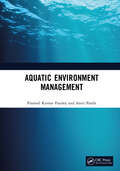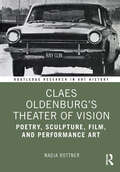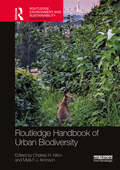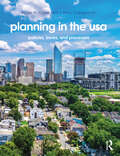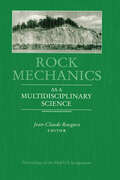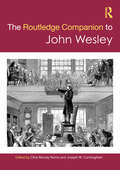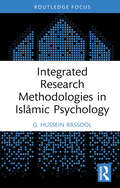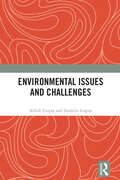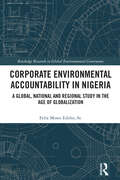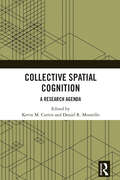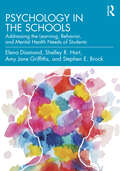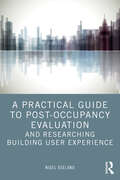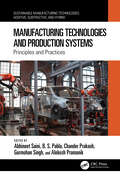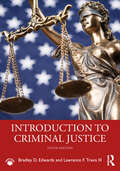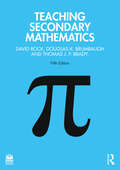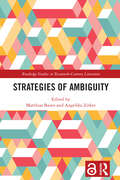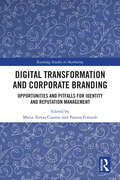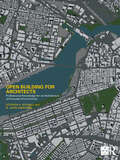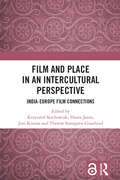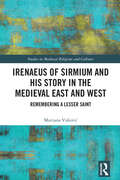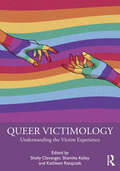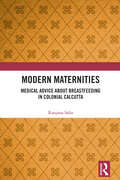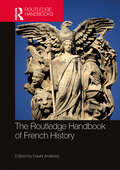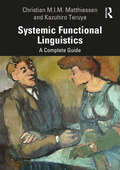- Table View
- List View
Aquatic Environment Management
by Pramod Kumar Pandey Amit PandeThis reference book collates traditional and modern applications of remote sensing in aquatic ecosystem monitoring. It covers conventional assessment methods like sampling, surveying, and chlorophyll estimation. Advanced remote sensing technology provides timely spectral information for quantitative and qualitative assessment of water changes, volume, and vegetation. The book discusses space-borne, airborne, and drone geospatial data. The five sections broadly cover aquatic ecosystem monitoring, vegetation management, advanced modelling practices, and challenges. Key features Covers different types of aquatic ecosystems like wetlands, rivers, lakes, saline, and brackish Reviews the latest applications of remote sensing in the monitoring and assessment of aquatic ecosystems Includes traditional methods like cartography, sampling, surveying, phytoplankton assessment and chlorophyll estimation Discusses the application of artificial intelligence, machine learning, data fusion in monitoring aquatic systems Explores the prospects of future Earth observation space missions for aquatic ecosystem monitoring The book is meant for scientists, professionals, and policymakers working in environmental sciences, remote sensing, and geology.
Claes Oldenburg's Theater of Vision: Poetry, Sculpture, Film, and Performance Art (Routledge Research in Art History)
by Nadja RottnerIn four chronologically organized chapters, this study traces the conceptual dependence and deep connectivity among Claes Oldenburg’s poetry, sculpture, films, and performance art between 1956 and 1965.This research-intensive book argues that Oldenburg’s art relies on machine vision and other metaphors to visualize the structure and image content of human thought as an artistic problem. Anchored in new oral history interviews and extensive archival material, it brings together understudied visual and concrete poetry, experimental films, fifteen group performances (commonly referred to as happenings), and a close analysis of his well-known installations of The Street (1960) and The Store (1961–62), effectively setting in place a reexamination of Oldenburg’s pop art from the street, store, home, and cinema years.The book will be of interest to scholars working in art history, film studies, performance studies, literature, intermedia studies, and media theory.
Routledge Handbook of Urban Biodiversity (Routledge Environment and Sustainability Handbooks)
by Charles H. Nilon Myla F.J. AronsonThis handbook provides a state-of-the-art, comprehensive overview of the expanding field of urban biodiversity.The field of urban biodiversity has emerged from within the broad discipline of urban ecology in the past two decades and is now a significant field in its own right. In view of this, the Routledge Handbook of Urban Biodiversity presents a thorough treatment of this field detailing the history of urban biodiversity, theoretical foundations, current state of knowledge, and application of that knowledge. The handbook is split into four parts: Part I: Setting the Stage for Urban Biodiversity Research and Practice Part II: Foundational Concepts and Theory in Urban Biodiversity Research Part III: Population and Community Ecology of Key Urban Taxa Part IV: Urban Biodiversity Practice: Management, Planning, and Design for Healthy Communities This volume contains interdisciplinary and global contributions from established and early career academics as well as professionals and practitioners, addressing two key fields in urban biodiversity: fundamental research focused on answering questions about the mechanisms explaining the distribution of species among and within cities; and applied research and work by practitioners to address concerns about urban biodiversity conservation, restoration, planning, design, and public involvement. This handbook is essential reading for students, academics, and professionals interested and working in the fields of urban biodiversity, ecology, nature conservation, urban planning, and landscape architecture.
Planning in the USA: Policies, Issues, and Processes
by Roger W. Caves J. Barry CullingworthExtensively revised and updated, Planning in the USA, fifth edition, continues to provide a comprehensive introduction to the policies, theory, and practice of planning.Outlining land use, urban planning, and environmental protection policies, this fully illustrated book explains the nature of the planning process and the way in which policy issues are identified, defined, and approached. The new edition incorporates new planning legislation and regulations at the state and federal layers of government and examples of local ordinances in a variety of planning areas. New material includes discussions of education and equity in planning the City Beautiful Movement Daniel Burnham’s plan for Chicago segregation Knick v. Township of Scott reforming single-family zoning and regulatory challenges in zoning and land use Daniel Parolek’s ‘Missing Middle Housing’ climate change, mitigation, adaptation, and resiliency the drinking water crisis in Flint, Michigan sharing programs for cars, bicycles, and scooters hybrid electric and autonomous vehicles Vision Zero COVID-19 relief for housing Innovation Districts, Promise Zones, and Opportunity Zones the sharing, gig, and creative economies scenic views and vistas, monuments, statues, and remembering the past; and healthy cities, Health Impact Assessment, and active living This detailed account of urbanization in the United States reveals the problematic nature and limitations of the planning process, the fallibility of experts, and the difficulties facing policy-makers in their search for solutions. Planning in the USA, fifth edition, is an essential book for students of urban planning, urban politics, environmental geography, and environment politics. It will be a valuable resource for planners and all who are concerned with the nature of contemporary urban and environmental problems.
Rock Mechanics as a Multidisciplinary Science: Proceedings of the 32nd U.S. Symposium
by Jean-Claude RoegiersPapers in the proceedings of the 32nd U.S. Symposium on Rock Mechanics were solicited to address the theme of 'Rock Mechanics as a Multidisciplinary Science'. The major goal was to assemble scientists and practitioners from various fields with interrelated interests in rock mechanics to share their common problems and approaches.The proceedings include three papers related to a special session on 'Lunar Rock Mechanics', as well as 121 technical papers covering areas such as: field observations, in-situ stresses, instrumentation/measurement techniques, fracturing, rock properties, dynamics/seismicity, modelling, laboratory testing, discontinuities/fluid flow, design, wellbore stability, and analysis.
Rock Mechanics as a Multidisciplinary Science: Proceedings of the 32nd U.S. Symposium
by Jean-Claude RoegiersPapers in the proceedings of the 32nd U.S. Symposium on Rock Mechanics were solicited to address the theme of 'Rock Mechanics as a Multidisciplinary Science'. The major goal was to assemble scientists and practitioners from various fields with interrelated interests in rock mechanics to share their common problems and approaches.The proceedings include three papers related to a special session on 'Lunar Rock Mechanics', as well as 121 technical papers covering areas such as: field observations, in-situ stresses, instrumentation/measurement techniques, fracturing, rock properties, dynamics/seismicity, modelling, laboratory testing, discontinuities/fluid flow, design, wellbore stability, and analysis.
The Routledge Companion to John Wesley (Routledge Religion Companions)
by Clive Murray Norris Joseph W. CunninghamThe Routledge Companion to John Wesley provides an overview of the work and ideas of one of the principal founders of Methodism, John Wesley (1703-91). Wesley remains highly influential, especially within the worldwide Methodist movement of some eighty million people. As a preacher and religious reformer his efforts led to the rise of a global Protestant movement, but the wide-ranging topics addressed in his writings also suggest a mind steeped in the intellectual developments of the North Atlantic, early modern world. His numerous publications cover not only theology but ethics, history, aesthetics, politics, human rights, health and wellbeing, cosmology and ecology. This volume places Wesley within his eighteenth-century context, analyzes his contribution to thought across his multiple interests, and assesses his continuing relevance today. It contains essays by an international team of scholars, drawn from within the Methodist tradition and beyond. This is a valuable reference particularly for scholars of Methodist Studies, theology, church history and religious history.
Integrated Research Methodologies in Islāmic Psychology (Islamic Psychology and Psychotherapy)
by G. Hussein RassoolThis book provides a foundation of the methodology of research scholarship in Islāmic studies, psychology and psychotherapy, offering an understanding of the concepts and techniques of Islāmic research methodology integrated with qualitative and quantitative research.Integrating Islāmic moral and epistemological values into research methodologies, the text synthesises research methodologies and approaches (empirical, rational) with Islāmic research scholarship. Chapters include a range of topics including research ethics from an Islamic perspective, systematic methodology of research in Islamic studies and social sciences and inductive and deductive approaches. Other questions covered include how to integrate the Qur’ân and Hadith (rules, concepts and statements) with psychological phenomena and how to write a research proposal and research paper. Each chapter includes rich case examples and relevant practical examples.This book is ideal for researchers and students in Islāmic psychology and psychotherapy wishing to learn more about the techniques and principles of Islāmic research scholarship in the field.
Environmental Issues and Challenges
by Abhik Gupta Susmita GuptaThis book explores the field of environmental studies emphasizing its multidisciplinary nature. It looks at the fundamentals of environmental conservation and the management of sensitive ecosystems.The book provides an overview of the basic concepts used to understand and study diverse ecosystems and their functions as well as the progressively larger yet mutually inclusive units, such as the landscape and the biome. It examines the challenges towards preserving biodiversity which is under severe threat due to climate change, exploitation of natural resources, pollution, and man-made disasters. Besides outlining the causes and effects, the authors outline control mechanisms to keep pollution within safe limits and offer suggestions for resolving issues such as wildlife poaching and trade, water and air pollution, deforestation, and biodiversity loss through policy changes.This book will be of interest to the students, researchers, teachers of environmental studies, environmental science, sociology, political science, and public administration. This book will also be useful to environmentalists, wildlife conservationists, and policy makers.
Corporate Environmental Accountability in Nigeria: A Global, National and Regional Study in the Age of Globalization (Routledge Research in Global Environmental Governance)
by Felix Moses EdohoThis book examines the imperative role of global environmental governance, and the need to incorporate corporate environmental accountability and mechanisms for enforcement, to effectively address the global environmental crisis.The author, Felix Moses Edoho, Sr., examines the issues at the various global, national, and regional levels. In Part I the book examines the issues at the global level and looks at the impact of transnational corporations (TNCs) and globalization on the global environmental crisis. Furthermore, it also examines the efforts of the United Nations in initiating global environmental architecture to tackle the crisis. Part II considers the issues at the national level and focuses on Nigeria. The author explores Nigeria’s regulatory and institutional framework for environmental governance and implementation. Lastly, at the regional level in Part III, the discourse centers on how decades of oil exploration and production have unleashed monumental ecological tragedies in the Niger Delta region of Nigeria due to the lack of corporate environmental accountability.This book will be of great interest to academics and students who are interested in broadening their knowledge of environmental governance and policy in developing countries. It will also be of value to environmental regulatory agencies and public administrators, development professionals, and TNCs.
Collective Spatial Cognition: A Research Agenda
by Kevin M. Curtin Daniel R. MontelloThis book integrates the science of spatial cognition and the science of team cognition to explore the social, psychological, and behavioral phenomenon of spatial cognition as it occurs in human collectives such as dyads and work teams.It represents the culmination of a process of outlining and defining a growing field of research termed Collective Spatial Cognition. It engages contributions from an international and multi-disciplinary community of scholars, who have collaborated to provide a foundation for knowledge discovery regarding how groups of people of varying size acquire information and solve problems involving spatiality as a key component, leading to action that incorporates the spatial information and problem-solving collectively achieved. The collectives under study can be as small as dyads (teams of two) to large teams-of-teams who are working alongside each other to complete a mutual goal. The book lays the foundation for multi- and interdisciplinary work regarding Collective Spatial Cognition in the years to come, and this book documents that foundation.This book will be of interest to those researching spatial, behavioural, cognitive, and information sciences in the fields of human geography, sociology, psychology, and computer science.
Psychology in the Schools: Addressing the Learning, Behavior, and Mental Health Needs of Students
by Elena Diamond Shelley R. Hart Amy Jane Griffiths Stephen E. BrockThis engaging and practical book addresses the multitude of ways in which school-employed psychological service providers such as school counselors, school psychologists, and school social workers, can support the learning, behavioral, and mental health needs of students in school settings.Psychology in the Schools offers vignette examples to apply content to real-world context and provides a variety of resources including worksheets and templates for practitioners to use in practice. Chapter content covers foundations in psychological services in schools (e.g., the hidden curriculum of school systems, professional standards of practice, consultation and collaboration, and assessment), an overview of social, emotional, behavioral, and academic supports across tiers of service delivery, and skills for practitioners to thrive (e.g., burnout prevention).This text is ideal for an upper-level undergraduate course or an introductory graduate-level course. Early career practitioners and supervisors alike can also benefit from the tools and resources that this book provides.
A Practical Guide to Post-Occupancy Evaluation and Researching Building User Experience
by Nigel OselandA Practical Guide to Post-Occupancy Evaluation offers high-level pragmatic guidance and case study examples on how to conduct a Post-Occupancy Evaluation (POE) to determine whether a workplace project is successful and uncover the lessons learned for future projects. For designers, POEs provide essential predesign feedback, informing the design brief to determine occupant requirements and help focus expenditure. For those in charge of a building or buildings, POE offers proactive building management and can also be used as part of the change management programme in larger projects, informing the occupants of progress. The practical guidance offered in this book will help the workplace industry understand if a design meets the requirements of an occupier and measure the success of and value offered by a workplace project.This book will be of interest to professionals in the workplace industry responsible for delivering and evaluating capital projects as well as those studying interior design, architecture, surveying, facilities management and building services engineering.
Manufacturing Technologies and Production Systems: Principles and Practices (Sustainable Manufacturing Technologies)
by Abhineet Saini B. S. Pabla Chander Prakash Gurmohan Singh Alokesh PramanikThe book, which is part of a two-volume handbook set, presents a collection of recent advances in the field of industrial engineering, design, and related technologies. It includes state-of-the-art research conducted in the fields of Industry 4.0/5.0, smart systems/industries, robotics and automation, automobile engineering, thermal and fluid engineering, and its implementation.Manufacturing Technologies and Production Systems: Principles and Practices offers a comprehensive description of the developments in industrial engineering primarily focusing on industrial design, automotive engineering, construction and structural engineering, thermo-fluid mechanics, and interdisciplinary domains.The book captures emerging areas of materials science and advanced manufacturing engineering and presents the most recent trends in research for emerging researchers, field engineers, and academic professionals.
Introduction to Criminal Justice
by Bradley D. Edwards Lawrence F. Travis IIIIntroduction to Criminal Justice, Tenth Edition, offers a student-friendly description of the criminal justice process—outlining the decisions, practices, people, and issues involved. It provides a solid introduction to the mechanisms of the criminal justice system, with balanced coverage of the issues presented by each facet of the process, including a thorough review of practices and controversies in law enforcement, the criminal courts, and corrections.In this revision, Edwards updates the statistics and research findings throughout. New sections include the impact of the COVID-19 pandemic, the recent shift to NIBRS crime reporting, and the increasing attacks on the legitimacy of the criminal justice system. This edition has also expanded coverage of police use of force and technological improvements. Selected chapters now include a case study box to demonstrate how certain laws, programs, and technologies have been used in particular situations.Appropriate for all U.S. criminal justice programs, this text offers great value for students and instructors.
Teaching Secondary Mathematics
by David Rock Douglas K. Brumbaugh Thomas J. BradySolidly grounded in up-to-date research, theory, and technology, Teaching Secondary Mathematics is a practical, student-friendly, and popular text for secondary mathematics methods courses. It provides clear and useful approaches for mathematics teachers and shows how concepts typically found in a secondary mathematics curriculum can be taught in a positive and encouraging way. The thoroughly revised fifth edition combines this pragmatic approach with truly innovative and integrated technology content throughout. Synthesized content between the book and a comprehensive Instructor and Student Resource website offers expanded discussion of chapter topics, additional examples, and technological tips, such as using and assessing artificial intelligence.Each chapter features tried-and-tested pedagogical techniques, problem-solving challenges, discussion points, activities, mathematical challenges, and student-life-based applications that will encourage students to think and do.New to the fifth edition: A fully revised chapter on technological advancements in the teaching of mathematics, including the use of artificial intelligence A new chapter on equity, shame, and anxiety in the mathematics classroom Connections to both the updated National Council of Teachers of Mathematics (NCTM) Focal Points and Standards Problem-solving challenges and sticky questions featured in each chapter to encourage students to think through everyday issues and possible solutions A fresh interior design to better highlight pedagogical elements and key features A completely updated Instructor and Student Resource site with chapter-by-chapter video lessons, teacher tools, problem solving Q&As, exercises, and helpful links and resources.
Strategies of Ambiguity (Routledge Studies in Twentieth-Century Literature)
by Matthias Bauer Angelika ZirkerThere has been a growing awareness that ambiguity is not just a necessary evil of the language system resulting, for instance, from its need for economy or, by contrast, a blessing that allows writers to involve readers in endless games of assigning meaning to a literary text. The present volume contributes to overcoming this alternative by focusing on strategies of ambiguity (and the strategic avoidance of ambiguity) both at the production and the reception end of communication. The authors examine ways in which speakers and hearers may use ambiguous words, structures, references, and situations to pursue communicative ends. For example, the question is asked what it actually means when a listener strategically perceives ambiguity, which may happen both synchronically (e.g. in conversations) as well as diachronically (e.g. when strategically ambiguating biblical texts in order to make them applicable to moral lessons). Another example is the question of whether ambiguity awareness increases the strategic use of ambiguity in prosody. Moreover, the authors enquire not only into the effects of ambiguous meanings but also into the strategic use of ambiguity as such, for example, as a response to censorship or as a means of provoking irritation. This volume brings together several contributions from linguistics, literary studies, rhetoric, psychology, and theology, and it aims to provide a systematic approach to the strategic production and perception of ambiguity in a variety of texts and contexts.The Open Access version of this book, available at http://www.taylorfrancis.com, has been made available under a Creative Commons Attribution-Non Commercial-No Derivatives 4.0 license.
Digital Transformation and Corporate Branding: Opportunities and Pitfalls for Identity and Reputation Management (Routledge Studies in Marketing)
by Maria Teresa Cuomo Pantea ForoudiTechnological advances, alongside increasing globalisation and growing awareness of socio-cultural and socio-political issues, are driving corporate branding innovations, and organisations must react and adapt quickly to compete. This book investigates and explores the impact of digital transformation on building corporate branding, identity, and reputation. The book brings together international contributors to provide examples from a wide range of industries and fi rms, including the retailing and agri-food industries, and illustrates the many dimensions of corporate branding and theories, and how they can be aided by digital transformation. It explores the connection of branding with artificial intelligence, social media networks, and technologies 4.0 as well the limitations and challenges they might deliver. Using a combination of theory, primary research findings, and practice, the book offers viewpoints and expertise from multiple regions, appealing to a global audience. This edited collection serves as an importance resource for researchers, scholars, and postgraduate students of marketing, brand management, and corporate communications, and those interested in the emerging relationship with technology.
Open Building for Architects: Professional Knowledge for an Architecture of Everyday Environment (Open Building)
by Stephen H. Kendall N. John HabrakenOpen Building is an internationally recognized approach to the design of buildings and building complexes with roots in the way the ordinary built environment grows and regenerates. The Open Building approach recognizes that both stability and change are realities to be managed in the contemporary built environment. Buildings – and the neighborhoods they occupy – are not static during the most stable times or during times of rapid social and technical change. They are living organisms that need constant adjustments to remain attractive, safe and valuable.Using case studies of built projects from around the world, this book explains the Open Building approach and discusses important characteristics of everyday built environment that the Open Building approach designs for. It also presents a key method that can be used to put the approach into use. It addresses questions such as: How can we design large projects for inevitable change? How can we balance the demands of large projects for efficient implementation with the need for ‘fine-grained’ decision-making control? How can we separate design tasks, one task being the design of what should last a century, the other task being the design of more mutable units of occupancy? How can we identify and share architectural themes and, at the same time, make variations on them? How can we use the Open Building approach to steward the earth’s scarce resources and contribute to a circular economy that benefits all people? This book is an essential resource for practitioners, investors and developers, regulators, builders, product manufacturers and educators interested in why the Open Building approach matters and how to practice Open Building.
Film and Place in an Intercultural Perspective: India-Europe Film Connections
by Krzysztof Stachowiak Hania Janta Jani Kozina Therese Sunngren-GranlundThe book offers an interdisciplinary overview of the film and place relationship from an intercultural perspective. It explores the complex domain of place and space in cinema and the film industry's role in establishing cultural connections and economic cooperation between India and Europe.With contributions from leading international scholars, various case studies scrutinise European and Indian contexts, exploring both the established and emerging locations. The book extends the dominantly Britain-oriented focus on India’s cinema presence in Europe to European countries such as Italy, Switzerland, Poland, Slovenia, Finland, and Sweden, where the Indian film industry progressively expands its presence. The chapters of this book look at Indian film production in Europe as a cultural bridge between India and Europe, fostering mutual understanding of the culture and society of the two regions.This interdisciplinary book will be of interest to researchers in film studies, cultural anthropology, cultural geography, tourism, economics, sociology, and cultural studies. It will also be interest to practitioners working in local authorities, destination management, tourism, and creative business, all of whom see the value of film production in attracting visitors, investment, and creating new networks with local economic actors. The book offers much-needed data and tools to translate their professional goals and potentials into effective regional strategies and activities.
Irenaeus of Sirmium and His Story in the Medieval East and West: Remembering a Lesser Saint (Studies in Medieval Religions and Cultures)
by Marijana VukovićThe study of hagiographies has generally been focused on the more prominent saints of late antiquity and the Middle Ages who inspired significant and long-lasting veneration. However, this has caused many less-well-known saints to be pushed aside and forgotten.This book is a study into one such saint, Irenaeus, a martyr who was killed in 304 CE in Sirmium, Pannonia. His short-lived cult, his feast day, and the account of his martyrdom (which had been translated into Latin, Greek, Old Slavonic, Georgian, and Armenian) had all been forgotten during the Middle Ages. This book examines Irenaeus of Sirmium’s life, cult, sainthood, and eventual disappearance from the memory of medieval Christendom, in the context of a wider study on the memory of those less-well-known saints who, like Irenaeus, became neglected and eventually forgotten.Irenaeus of Sirmium and His Story in the Medieval East and West will be of interest to scholars and students alike interested in hagiography, medieval literature and history, as well as all those interested in the religious history of Byzantium, medieval Europe, and the Slavic world.
Queer Victimology: Understanding the Victim Experience
by Shelly Clevenger Shamika Kelley Kathleen RatajczakThis book provides a much-needed focus on the victimization experiences of those within the lesbian, gay, bisexual, transgender, Queer, intersex, or asexual (LGBTQIA) communities. With original research and scholarly work relating to victimization, supplemented by stories and poems detailing firsthand accounts by people in LGBTQIA communities, the volume editors shine a light on the experiences of those who have been harmed or who have suffered because of who they are. Allowing the reader to gain a deeper understanding of Queer victimization and LGBTQIA victims, the volume delves into how and why people are victimized, as well as how the criminal justice system and other social services interact with victims and each other. The creative pieces included give a direct voice to those who have most often been silenced in the past.Queer Victimology is essential reading for scholars and students in the areas of criminology, victimology, sociology, gender studies, education, counseling, and/or psychology as well as anyone engaged with Queer, critical, and feminist criminologies, gender studies, diversity, and criminal justice.
Modern Maternities: Medical Advice about Breastfeeding in Colonial Calcutta
by Ranjana SahaModern Maternities: Medical Advice about Breastfeeding in Colonial Calcutta brings to light rare textual and visual materials on medical opinions about breastfeeding by memsahibs (European women), dais (indigenous midwives and/or wet nurses) and the bhadramahila (here the focus is on ‘respectable’ Bengali-Hindu women). With the help of archival resources, the author discusses themes like: modernity, maternities and medicine intersections of ‘race’, gender, class, caste, community and age in diet artificial foods versus wet nursing ‘cleanliness’, corporeality and culture ‘clean midwifery’ versus ‘dirty midwifery’ customary breastfeeding practices child-mothers and childcare breastfeeding, mothercraft and modern clocks exhibitions, baby shows and baby weeks colonialism and anti-colonial nation-building The book offers critical insights into social histories of medicine, motherhood and childcare in nineteenth and early twentieth century colonial Calcutta. It is intended for anyone interested in the book’s interdisciplinary focus on the regional, national and global resonances of childrearing advice. In particular, it will interest scholars and researchers from modern Indian history, global history, health history, medical anthropology, gender studies and South Asian studies.
The Routledge Handbook of French History
by David AndressAimed firmly at the student reader, this handbook offers an overview of the full range of the history of France, from the origins of the concept of post-Roman "Francia," through the emergence of a consolidated French monarchy and the development of both nation-state and global empire into the modern era, forward to the current complexities of a modern republic integrated into the European Union and struggling with the global legacies of its past.Short, incisive contributions by a wide range of expert scholars offer both a spine of chronological overviews and a diverse spectrum of up-to-date insights into areas of key interest to historians today. From the ravages of the Vikings to the role of gastronomy in the definition of French culture, from Caribbean slavery to the place of Algerians in present-day France, from the role of French queens in medieval diplomacy to the youth-culture explosion of the 1960s and the explosions of France’s nuclear weapons program, this handbook provides accessible summaries and selected further reading to explore any and all of these issues further, in the classroom and beyond.
Systemic Functional Linguistics: A Complete Guide
by Christian M.I.M. Matthiessen Kazuhiro TeruyaThis user-friendly student guide is the essential resource for all those engaged in studying systemic functional linguistics (SFL).Assuming no prior knowledge, this guide is divided into nine chapters which can be read independently of one another and used for purposes of reference. The reading section maps out and mediates the key SFL literature. The application guides show how SFL has been and can be applied to various domains, from translation to healthcare communication. The term guides demystify the core terminology and the vocabulary guides aid readers in dealing with the most commonly used terms in text analysis.Systemic Functional Linguistics is an invaluable guidebook for all those studying functional grammar and SFL within linguistics, applied linguistics and related courses.
